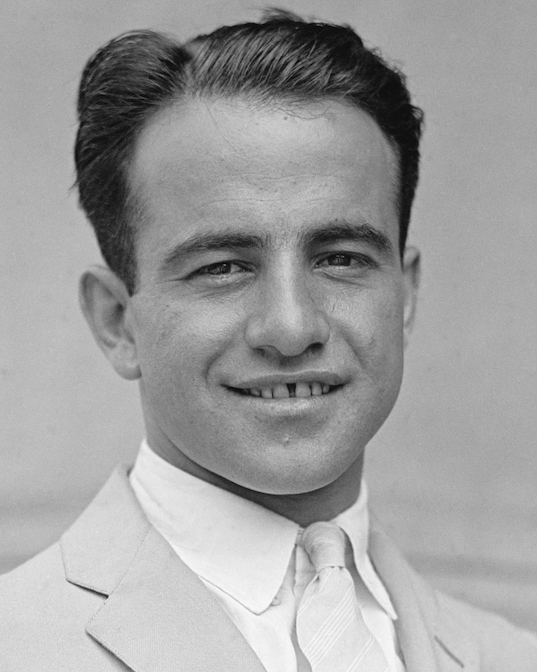
Sport: Auto Racing
Born: April 6, 1898
Died: November 26, 1980
Town: Roseland, New Jersey
Peter DePaolo was born April 6, 1898 in Philadelphia and grew up in Roseland, NJ. His father was a local homebuilder and he had many advantages in life other boys did not. Something else Pete had was a famous uncle, Ralph DePalma, an auto racing icon whom he idolized. Uncle Ralph was his mother’s brother and encouraged him to pursue his love of engines. This he did as a teenager and served in World War I as an airplane mechanic. Upon his return, Pete landed a job in New York City as a chauffeur/mechanic.
In 1919, Pete saw his first board-track race and he was hooked. His Uncle squared off against fellow legends Barney Oldfield and Louis Chevrolet in Sheepshead Bay. DePalma won easily. Starting in 1920, Pete became DePalma’s riding mechanic. DePalma’s advice to his nephew was, “Keep your mouth shut and your eyes open, and you’ll be good driver someday.”
Needless to say, this was the thrill of a lifetime, but not without its risks. At the 1920 Indianapolis 500, Uncle Ralph ordered him to put out a fire in the engine—while they continued to race at close to 100 mph. Pete climbed to the front of the car and, straddling the bumper and holding onto the hood ornament, he took the fire extinguisher from DePalma and completed his task before climbing back into the passenger seat. They were leading the race when the car stalled on Lap 187. Pete sprinted to the pits for gasoline, but by the time they rejoined the race several cars had passed them and they finished fifth.
Pete fulfilled the same role during the 1922 Indianapolis 500, when he and Ralph finished fourth. By then, Pete was already making a name for himself on the board-racing circuit. In 1924, he qualified for the Indy 500 himself, driving for the Duesenberg brothers, August and Fred. He finished sixth. That season, Pete won his first major race, a 150-mile event on the super-steep board track in Fresno, CA, edging Harry Hartz.
Pete put a lot of thought into his strategy for the 1925 race. His uncle had not competed in 1924, but this year DePalma would be one of several men driving powerful Millers, including Hartz and Tommy Milton. From past experience, Pete knew there would be a narrow oil slick in the middle of the track. To save his treads, he drove two laps with his left tires in the slick and two with his right tires in the slick, switching back and forth. He forged a sizeable lead, but controlling the car was difficult and he developed bad blisters on his hands. Norm Batten, a member of his pit crew, took the wheel for 21 laps while Pete’s hands were being bandaged. When he resumed racing, he was in fifth place, but quickly made up the difference and won with a record-setting average speed over 100 mph. Pete went on the win the AAA driving championship that season by one of the largest margins in history, with 3,250 points.
In 1926, Pete was within striking distance of the leaders when the Indianapolis 500 ended after 400 miles due to bad weather. The following season, Pete formed his own team and, after finishing second at Indy, went on to win another AAA series driving championship. Pete crashed in practice for the 1927 Indy race and ended up in the hospital, depriving fans of one of their favorite drivers. Just before the race began, an ambulance pulled into The Brickyard and Pete was wheeled out in a stretcher to watch the start to the delight of the crowd.
Pete came back to compete in the Indy 500 in 1928, 1929 and 1930. In the 1930 race he pitted after just nine laps and insisted to his crew something didn’t feel right. Relief driver Red Roberts jumped in and ended up hitting a wall on Lap 20.
During the 1930s, Pete did a lot of racing in Europe. In 1934, he threw two connecting rods during a race in Germany, with the debris whizzing into the crowd and barely missing Adolph Hitler, who was sitting in a trackside box. Later that year, a crash in Spain left Pete in a coma for 11 days and he decided it was time to retire. He returned to The Brickyard in 1935 as a team manager for Kely Petillo, who won the race.
Pete continued to forge a career in the sport during the 1940s and 1950s, ultimately managing Ford’s entry into factory stock car racing. Later he served in an executive role at Michigan International Speedway. In 1971, Pete was invited back to The Brickyard, where he sang “Back Home Again In Indiana” before the race. Pete passed away in California at the age of 82 in 1980.